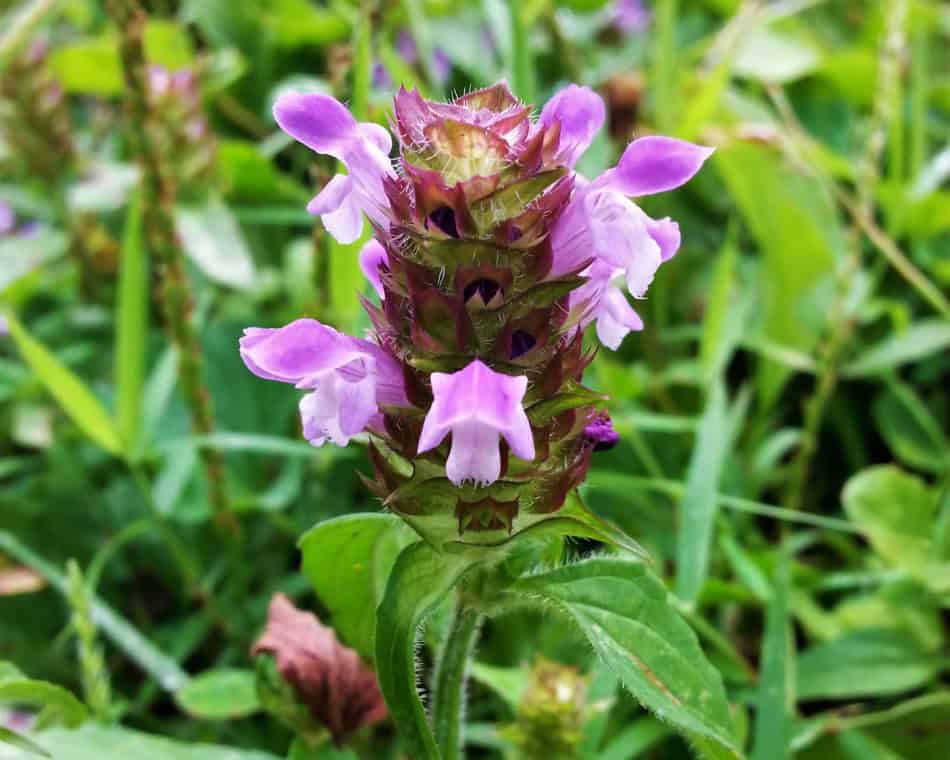
One of the more common wildflowers (that is often overlooked) with a very interesting flower structure is commonly known as Self-Heal or Heal All. The flowerheads are incredibly interesting to look at in that they have similarities to pineapple or pinecones in structure, with the ascending ‘scales’ interspersed with flowers. But these flowers are shorter, and are not commonly cultivated in flower gardens due to their tendency to self-seed and become a bit weedy. Nonetheless, Self-Heal or Heal-All is a nectar producing plant that is very attractive to numerous bees and butterflies. And it is adaptable enough to have colonized most of the world.
Scientifically known as Prunella vulgaris, it is a short-lived perennial wildflower native to most of North America. It grows upwards of 12″ tall in moist to medium-moist soil and full to partial sun. It’s blooms attract many species of bee and several species of small butterflies[1][2][3].
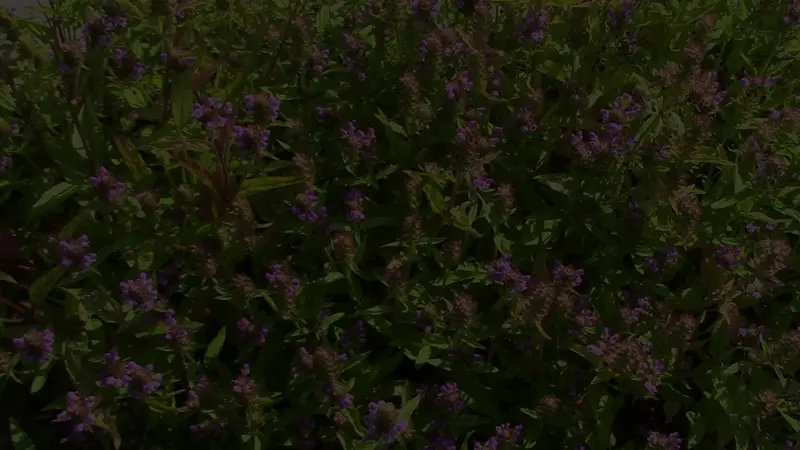
Known for centuries as a medicinal herb, Self-Heal has been used for treating wounds, fever, and other ailments[4]. It is used in salves, as tea, and can readily be purchased as a supplement. So, whether you want to improve the ecological value of your lawn or are looking to add Self-Heal to a medicinal herb garden, I can help you do that by showing how I’ve grown it for years.
Facts
- Native to almost ALL of North America. Only the extreme Northern Canadian provinces do not have Self-Heal.
- Self-Heal is also a rare plant in that it is native to Europe and Asia
- Is ecologically beneficial, as it provides nectar and pollen to many bees and small butterflies/skippers.
- Has been used medicinally for hundreds of years. It was used by the Native Americans, then by herbalists.
- Self-Heal is high in antioxidants, and has high anti-viral and antimicrobial properties
- A member of the mint family, Self-Heal will spread via rhizome roots and can become aggressive or weedy
- Self-Heal can grow within a lawn, and bloom even if repeatedly mowed.
- Mowing/cutting of Self-Heal will increase the amount of surface area the plant covers.
Native Range
Self Heal is a common flower that is native to nearly all of the United States and Canada. But this is one of those rare plants that has it’s native range spanning the oceans, extending to Africa, Asia, and Europe.

Reference Table
| Scientific Name | Prunella vulgaris |
| Common Name(s) | Self-Heal, Brown Root, Blue Curls, Heal All, Self Heal, Heal-All |
| Native Range, USDA Zone | North America, Africa, Asia, Europe |
| Bloom Time | Summer |
| Bloom Duration, Color | Four weeks, purple/white |
| Height | 6-12″ |
| Spacing / Spread | 12″ |
| Light Requirements | Full sun to part-shade |
| Soil Types | Sandy-loam to clay-loam |
| Moisture | Moist to medium-moist soil |
| Fauna Associations / Larval Hosts | Bees, butterflies & skippers |
Benefits
Beauty
The unique flower structure of Self-Heal is incredible beautiful. When blooming, this is a very attractive plant when viewed up close. And if sufficient moisture is present, the foliage will look good all year.
Adaptable
As the native range shows, this plant is highly adaptable to many areas in the world. As long as it doesn’t fully dry out and the soil can drain, this plant can pretty much grow.
Deer and Rabbit resistant
The bitter foliage keep deer and rabbits away. So, you won’t be battling the critters to stop eating this plant.
Medicinal / Edible
The plant has been used medicinally for wounds, fever, and several other ailments. In fact you can even buy this as a supplement.
Identification and Characteristics
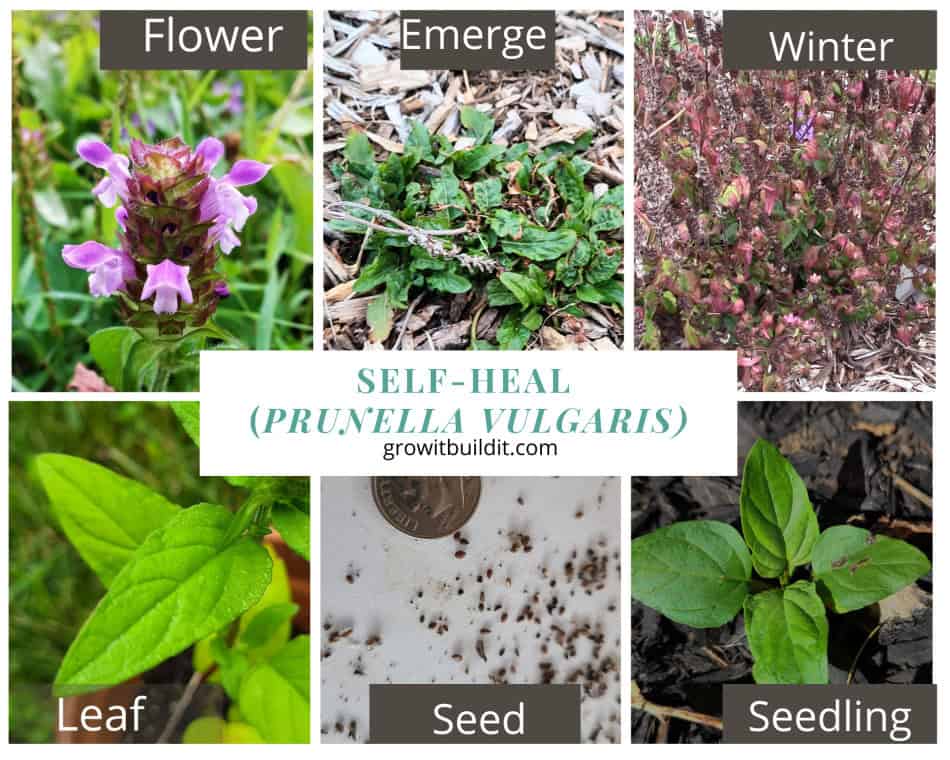
Stalk
The overall height of this plant depends on conditions, but in general the stalk will reach 12″ tall given the opportunity with full sun and moist, well-draining soil. But the stalk is a square-stemmed plant with white hairs on the angles and light green in color[2].
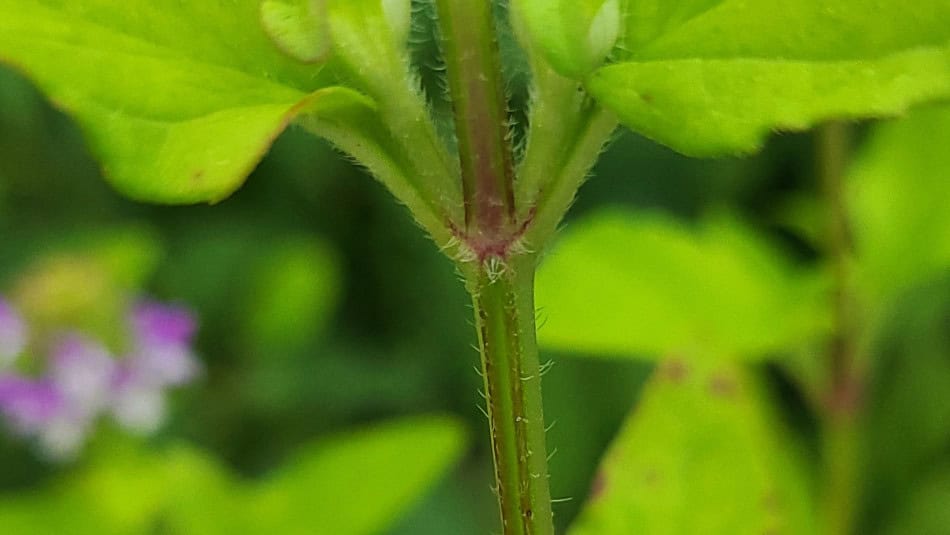
Leaf
Leaves are opposite (arranged in pairs, with each pair rotated 90 degrees from the previous), green in color, and up to 2″ long by 1″ wide with lanceolate or ovate shaped. In general the margins (edges) are smooth[2].
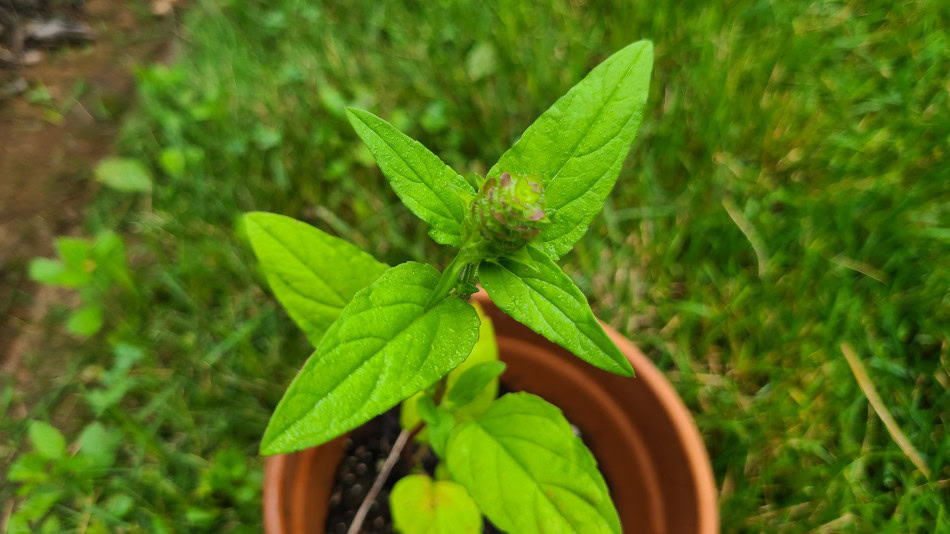
Flower
At the end of the stalk there will be a short spike flowerhead with two-lipped, tubular flowers arrayed around and along the flowerhead axis. The upper lip is usually dark purple to light pink, while the lower one is white with two lobes[2].
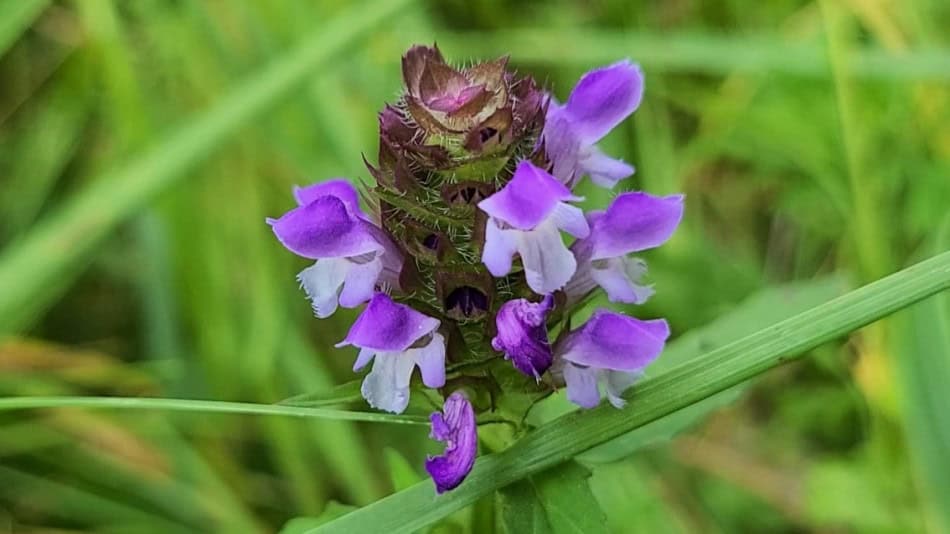
Root
The root system is a short taproot, with some lateral fibrous roots. Some varieties can spread by stolon.
Growing Conditions
Self-heal will prefer full sun in moist to medium-moist, well-draining soil. It can tolerate part-sun, which is 4-6 hours per day. But the key factors for maintaining a population of Self-Heal is to know that it is not drought tolerant, but needs well-draining soil. The easiest locations to grow it are along forest edges that can provide some shade, and in lawns that receive afternoon sun.
How to save seed from Self-Heal
Self-heal flowerheads will turn brown about six weeks after blooming. Now, the seed heads will persist throughout winter, but the seed will often fall down by then. So I recommend not waiting around to harvest, and to do so by Thanksgiving.
But to harvest the seed, get a container or paper bag and go to the plant. Carefully snip off the stalk below the seed head, and take care to keep the seed head vertical. Also, don’t bump it, as the seeds are somewhat easy to dislodge.
Place your container in a cool dry place, like a garage, for about a week. Then, vigorously shake the bag or container to release most of the seed. Pass this through a common handheld kitchen strainer to sift the seed and leave most of the chaff. You can store these seeds in a baggy or envelope until you are ready to winter sow them. I’m afraid I don’t have much info in terms of the longevity of the seed, so I would plan to use it by the following spring.
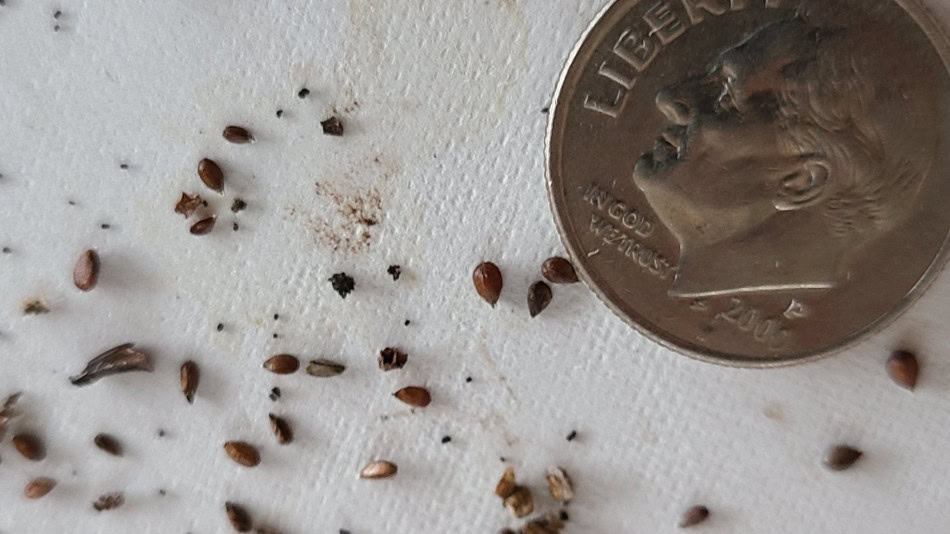
How to Grow Self-Heal from Seed
Self-Heal seeds need to experience a winter period before germinating. This process is known as cold-moist stratification, where you subject the seed to a cold moist environment for about 30 days prior to sowing. You can achieve this by using a moist paper towel in a sealed container in the fridge (see our guide here), or by winter sowing the seed between Fall and very early Spring (see my guide on winter sowing here).
But for planting stratified seed or winter sowing;
- Fill a suitable container with moist potting soil.
- Sprinkle seed on top of the soil, then press in with your thumb or hand to ensure good contact
- Place the container in a location with morning sun and afternoon shade
- Germination usually occurs within a couple of weeks of temperatures warming up to 60-70F

Direct sowing self-heal
Additionally you can direct sow Self Heal from Fall to late winter. Simply scatter the seed on disturbed soil, then walk on it to ensure good contact. Germination should occur not long after soil temperatures get above 50F.
Wildlife, Pests, and Diseases associated with Self-Heal
Pollinators
Self-Heal will attract a variety of short and longtongue bees as well as a variety of butterflies (skippers, sulfurs)[5]. The plants are quite busy when planted in groups of 4-7 (which is the most I’ve clustered in a garden).
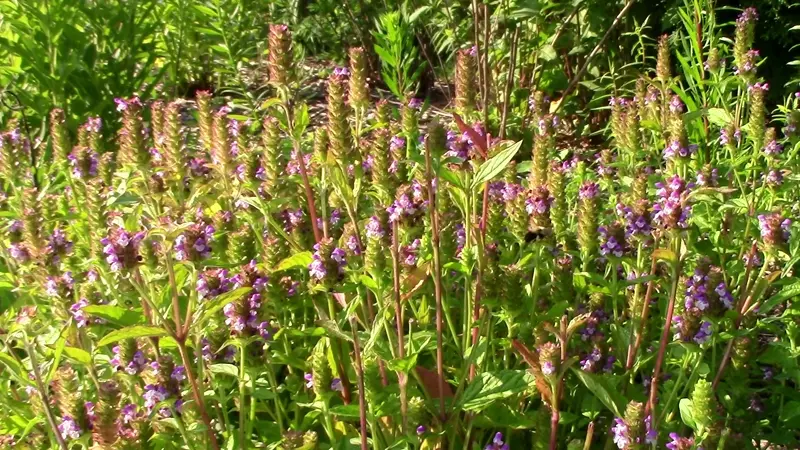
Deer and Rabbits
In general, this plant is not browsed by deer or rabbits as the foliage as a strong flavor[2].
Disease
The only diseases that seem to effect Self-Heal are fungi which attack plants in excessively moist environments, where that moisture can build up on the surface of the plant. Powdery mildew, leaf-spot and other diseases set in on plants in these environments.
Also, plants that suffer from extreme drought or stressed are more likely to succumb to disease.
Where you can buy Self-Heal
Self-heal is not typically sold in nurseries, as it isn’t a typical ‘garden friendly’ plant. But it can be purchased at specialty nurseries that deal in Native Plants. You can find native plant nurseries near you on our interactive map.
Where to buy seeds
We have ordered a variety of native flower seeds from Everwilde Farms (and they sell self-heal), which you can order right from Amazon through our link on our RECOMMENDED PRODUCTS PAGE. (We may earn a small commission when you purchase through our links, at no cost to you. This helps support our website.)
Uses of Self-Heal
Landscaping
Self-heal is not typically used in landscaping as the plant has a tendency to self seed in it’s optimum growing conditions. And this should be unsurprising considering the vast range that this plant covers (nearly the whole world). This self-seeding usually amounts to about 20-30 minutes to pluck seedlings in Spring. You just need to identify the seedlings.
But is a low-growing plant that can look good for most of the season. However meticulous gardeners may not like the brown seed heads that will be shown by late summer. However, it is easy enough to remove those in a few minutes.
And finally, this is a native plant that can grow right in your lawn as long as you have your mower set high enough. The key factor to making it work is to have afternoon shade. That really helps provide some moisture for it, which is necessary for it’s survival.
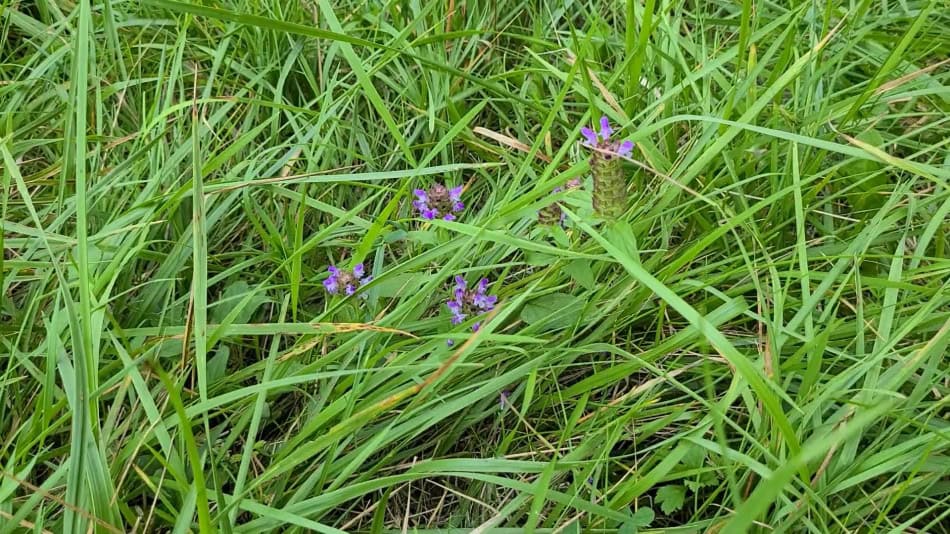
Companion Plants
Self-heal will grow well with numerous other plants that like some moisture and well-draining soil. Some suggestions would be the following:
- Blue Lobelia
- Columbine
- Perennial Black Eyed Susan
- Prairie Dropseed (grass)
- Sweet Goldenrod
- Tennessee Coneflower
- Winecups
Medicinal Uses
Like the common name would imply, Self-Heal has been used medicinally by many Native American Tribes. In fact over 50 uses have been documented by 15 Tribes[6]. The sap would be rubbed on boils or wounds to heal them[2][6]. While other tribes would make tea to help reduce fevers.
Modern studies have found antibacterial properties, antioxidants, as well as it may improve over various symptoms such as lowering blood pressure[7][8]. But it is sold and used as a medicinal herb today as well as used in salves and teas[9][10].
Conclusion
A very attractive plant, self-heal can be used in gardens for it’s attractive flowers and long bloom time. And many people may choose to grow it for their own medicinal reason. But you just need to be prepared to account for self-seeding. I prefer to use this along forest edges, or directly in the grass, as it will add some ecological value in the form of nectar, as opposed to having just grass.
Find more native plants here
References:
[1] – Prunella vulgaris L. USDA NRCS.
[2] – Young-Mathews, Annie. LANCE SELFHEAL Prunella vulgaris L. ssp., USDA NRCS Plant Guide.
[3] – Singer, Carolyn. Deer in My Garden Volume 2, Groundcovers and Edgers. Garden Wisdom Press, 2009, p138
[4] – Rasool, Rafia, and Bashir A. Ganai. “Prunella vulgaris L.: a literature review on its therapeutic potentials.” Pharmacologia 4.6 (2013): 441-448.
[5] – Robertson, Charles. “Flowers and insects; lists of visitors of four hundred and fifty-three flowers.” (1928).
[6] – Prunella vulgaris, North American Ethnobotany Database
[7] – Zhang, Guowen, Li He, and Mingming Hu. “Optimized ultrasonic-assisted extraction of flavonoids from Prunella vulgaris L. and evaluation of antioxidant activities in vitro.” Innovative food science & emerging technologies 12.1 (2011): 18-25.
[8] – Li, Chao, et al. “Characterization, antioxidant and immunomodulatory activities of polysaccharides from Prunella vulgaris Linn.” International Journal of Biological Macromolecules 75 (2015): 298-305.
[9] – Tan, Rachael, Jue Xi Lai, and Wai Mun Loke. “Antioxidant and Anti-inflammatory Properties of Prunella vulgaris Tea.” Current Research in Nutrition and Food Science 10.2 (2022): 521.
[10] – Roh, Kyung-Baeg, Deokhoon Park, and Eunsun Jung. “Inhibitory effects of Prunella vulgaris L. extract on 11β‐HSD1 in human skin cells.” Evidence‐Based Complementary and Alternative Medicine 2018.1 (2018): 1762478.
Recent Posts
Got a flat wheelbarrow tire? You've come to the right place. I've repaired them multiple times. Whether you rolled it over a nail or the tube just became a bit worn, you can fix it and I will show...
Downy Wood Mint is a perennial wildflower native to Eastern North America[1]. Scientifically known as Blephilia ciliata, it grows 12-30” tall in full sun and well-draining soil[2][3]. Blooming...

